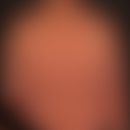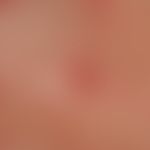Synonym(s)
HistoryThis section has been translated automatically.
DefinitionThis section has been translated automatically.
You might also be interested in
EtiopathogenesisThis section has been translated automatically.
Unknown, no familial occurrence. Provocation by local irritation, sunlight, xerosis, increased sweating and heat are possible.
Several chemotherapeutic agents have been associated with Grover's disease such as daunorubicin, cytarabine, idarubicin, etoposide and docetaxel (Afvari S et al. 2022). Furthermore, CTLA4 inhibitors seem to favor the occurrence of M.Grover (Uemura M et al. 2016).
ManifestationThis section has been translated automatically.
LocalizationThis section has been translated automatically.
Clinical featuresThis section has been translated automatically.
The clinical picture is extremely variable. There is always severe pruritus. In the clinical picture originally described by Grover, symmetrically arranged, disseminated, succulent, nonconfluent papules and papulovesicles are found.
Cases with a zosteriform as well as with a blaschkoid distribution pattern have been described; in this constellation, an eruptive linear Darier's disease must be differentiated, which is very difficult (di Meo N et al. 2017).
Nikolski phenomenon I and Nikolski phenomenon II are negative (papulovesicular type).
Bullous forms resembling pemphigus vulgaris, papular forms without the formation of vesicles, and papulokeratotic forms (similar to dyskeratosis follicularis) are rare.
HistologyThis section has been translated automatically.
Acantholysis with subcorneal or suprabasal cleft formation, spongiosis and dyskeratosis. A distinction is made between:
- Darier type
- spongiotic type
- Hailey-Hailey type and
- pemphigus type.
Often several types coexist in one histological section!
In the dermis, a monomorphic, lymphohistiocytic infiltrate is detectable in the papillary dermis.
Direct ImmunofluorescenceThis section has been translated automatically.
Indirect immunofluorescenceThis section has been translated automatically.
Differential diagnosisThis section has been translated automatically.
External therapyThis section has been translated automatically.
Glucocorticoid creams such as 0.25% prednicarbate (e.g. Dermatop cream), 0.1% mometasone (e.g. Ecural fat cream) or 0.1% methylprednisolone (e.g. Advantan cream), lotio alba on top.
Therapy trial especially in case of excruciating pruritus with PUVA therapy or UVB/UVA irradiation.
Internal therapyThis section has been translated automatically.
Glucocorticoids: 10-20 mg prednisolone equivalent/day(e.g. Urbason 8-10 mg or Decortin Tbl. 15-20 mg). Additional therapy with antihistamines such as desloratadine (e.g. Aerius) 5-10 mg/day or levocetirizine (e.g. Xusal) 5-10 mg/day. In extremely therapy-resistant cases, try therapy with isotretinoin (e.g., Isotretinoin-ratiopharm; Acnenormin) 30-40 mg/day. Caveat. Safe anticonception in women of childbearing age is mandatory!
Alternatively acitretin (Neotigason Kps.) 20-30 mg/day.
Alternative: successes have been described with dupilumab (Butler DC et al. 2021).
Progression/forecastThis section has been translated automatically.
LiteratureThis section has been translated automatically.
Afvari S et al (2022) Grover disease associated with docetaxel chemotherapy. JAAD Case Rep 29:86-88.
- Bergua P et al (2003) Congenital acantholytic dyskeratotic dermatosis: localized Darier disease or disseminated benign papular acantholytic dermatosis? Pediatr Dermatol 20: 262-265
- Butler DC et al (2021) Treatment of Grover Disease With Dupilumab. JAMA Dermatol 157:353-356.
- di Meo N et al (2017) Monolateral Grover's disease with blaschkoid distribution. Acta Dermatovenerol Croat 25: 31-311.
- Fantini F et al (2002) Unilateral transient acantholytic dermatosis (Grover's disease) along Blaschko lines. J Am Acad Dermatol 47: 319-320.
- Grover RW (1970) Transient acantholytic dermatosis. Arch Dermatol 101: 426-434.
- Kiwan RA et al (2002) Grover disease (transient acantholytic dermatosis) and piebaldism. Cutis. 69: 451-453
- Lang I et al (1986) The spectrum of transient acantholytic dermatoses. Dermatologist 37: 485-493
- Muntyanu A et al (2021) Cutaneous immune-related adverse events (irAEs) to immune checkpoint inhibitors: A Dermatology Perspective on Management. J Cutan Med Surg 25: 59-76.
- Rodríguez-Pazos L et al (2015) Grover's disease in chronic kidney failure. Nefrologia 35:331-334.
- Sakalosky PE et al (2002) A case of acantholytic dermatosis and leukemia cutis: cause or effect? Am J Dermatopathol 24: 257-259.
- Scheinfeld N et al (2007) Seasonal variation of transient acantholytic dyskeratosis (Grover's disease). J Am Acad Dermatol 55: 263-268.
- Streit M et al (2000) Transitory acantholytic dermatosis (Grover's disease). An analysis of the clinical spectrum based on 21 histologically assessed cases. Dermatologist 51: 244-249
- Uemura M et al. (2016) A case report of Grover's disease from immunotherapy-a skin toxicity induced by inhibition of CTLA-4 but not PD-1. J Immunother Cancer 4:55.
Incoming links (15)
Acantholysis; Dermatosis acantholytic transient; Dermatosis benign papular acantholytic; Dermatosis transitory acantholytic; Dyskeratosis; Dyskeratosis follicularis; Dyskeratosis, incidence, focal, acantholytic; Eczema herpeticum; Galli-galli disease; Grover, m.; ... Show allOutgoing links (26)
Acantholysis; Acitretin; Antihistamines, systemic; CTLA4; Dermatitis herpetiformis; Desloratadine; Dupilumab; Dyskeratosis; Dyskeratosis follicularis; Glucocorticosteroids; ... Show allDisclaimer
Please ask your physician for a reliable diagnosis. This website is only meant as a reference.


















